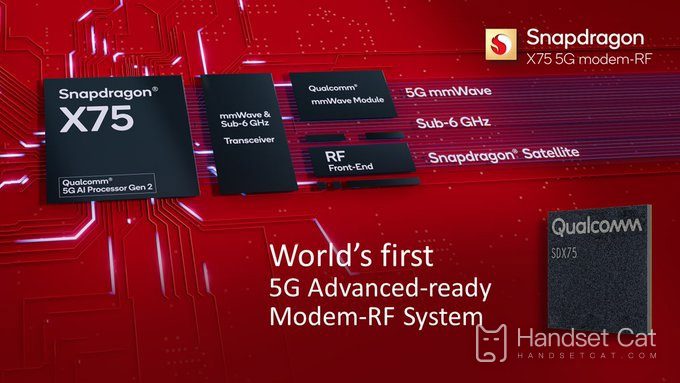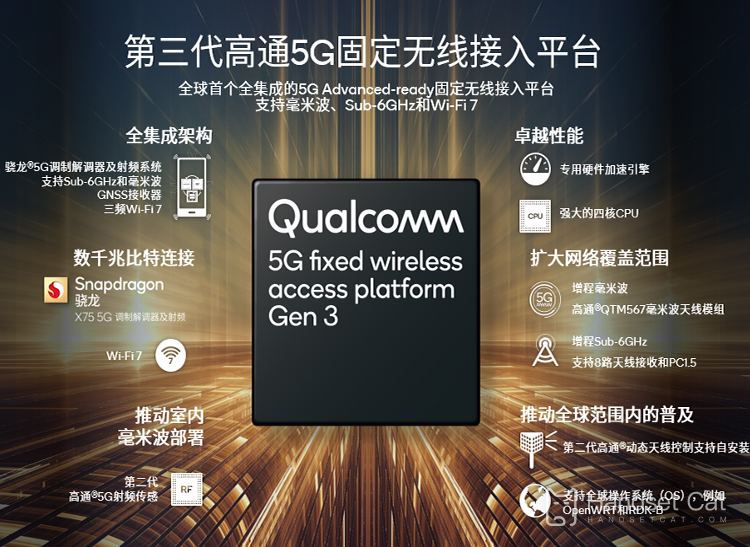Qualcomm officially released Snapdragon X75 5G baseband chip: see the first batch of "5G Advanced-ready" for commercial use in the second half of the year
Users who often browse the mobile phone circle should know that the baseband chip is very important for the most core processor of mobile phones, even if it can directly affect the performance of the processor. Just yesterday (February 15), Qualcomm officially released the new generation of Snapdragon X75 5G baseband chip. As a sequel to X70, it also brought a new "5G Advanced-ready"!

On February 15,Qualcomm announced the launch of the Snapdragon X75 5Gmodem and RF system, which is also the world's first "5G Advanced-ready" baseband product.supports 10-carrier aggregation, and promises to achieve 10Gbps downlink speed in Wi-Fi 7 and 5G.
5G Advanced-ready is between 5G and 6G, also known as "5.5G" in the industry. It will achieve better results in upgrading the XR field, the Internet of Vehicles, and the 5G uplink communication capabilitySnapdragon X75 is currently in the process of sampling, and the commercial terminal is expected to be released in the second half of 2023. The technology and innovation of Snapdragon X75 enable OEMs to create a new generation of experience across segments, including smart phones, mobile broadband, automobiles, computing, industrial Internet of Things, fixed wireless access (FWA) and 5G enterprise private networks.
Detailed viewing address: https://weibo.com/tv/show/1034:4869467205992503?from=old_pc_videoshow
Qualcomm Snapdragon X75 modem is the official follow-up product of the Snapdragon X70 modem launched in 2022, and is expected to be used in the Snapdragon 8 Gen 3 smartphone. The modem provides many upgrades, of which the most noticeable is the20% energy efficiency improvement.
The mobile cat learned that this new modem includes full band support from 600MHz to 41GHz. In this baseband chip, millimeter wave mmWave hardware (QTM565) is integrated with Sub-6 hardware. This places all 5G connections on one module. According to Qualcomm, this provides simpler manufacturing, and the physical area of some chips is reduced by 25%. In addition, putting mmWave/Sub-6 on one chip can improve energy efficiency by up to 20% compared with X70. The new QTM565 millimeter wave antenna module is matched with the integrated transceiver, reducing the cost, circuit board complexity, hardware occupancy and energy consumption. On this basis, Qualcomm's 5G PowerSave Gen4 and its RF efficiency suite are also committed to further extending battery life.
In other aspects, the artificial intelligence of the chip has also been greatly enhancedSnapdragonX75 is also the first modem system with dedicated hardware tensor accelerator. Compared with the first generation of chips in the X70 last year, the second generation of Qualcomm 5G artificial intelligence processor promises to improve AI performance by 2.5 times, which means that the best frequency can be selected more intelligently to achieve the best connection. Qualcomm claims that the positioning accuracy of Gen 2 is improved by 50% due to the use of GNSS positioning. This not only reduces power consumption, but also improves connection stability. This is complementary to the new second-generation intelligent network choice.

The third-generation Qualcomm fixed wireless access platform with Snapdragon X75 is the world's first fully integrated 5G Advanced-ready fixed wireless access platform, which not only supports millimeter wave, Sub-6GHz, but also supports Wi-Fi 7 and 10Gb Ethernet capabilities.
The new platform provides excellent performance with quad-core CPU and dedicated hardware acceleration, aiming to support peak performance across 5G cellular, Ethernet and Wi-Fi. With the above enhanced functions, the third-generation Qualcomm fixed wireless access platform will support a new type of all-wireless broadband, providing thousands of megabits of transmission speed and wired low latency for almost all terminals in the home. In addition, the third-generation QUALCOMM fixed wireless access platform will help provide mobile operators with a wide range of applications and value-added services, and bring them cost-effective deployment methods - through 5G wireless networks to provide fiber-like Internet speed for rural, suburban and densely populated urban communities, promote the popularization of fixed wireless access worldwide and further narrow the digital divide.

In addition to the functions brought by Snapdragon X75, the key features of the third-generation Qualcomm fixed wireless access platform also include:
The hardware architecture integrating millimeter wave and Sub-6GHz will reduce the board area, cost, board complexity and power consumption.
The second generation of Qualcomm dynamic antenna control can enhance the self-installation function.
Qualcomm RF sensing suite can support indoor millimeter wave CPE deployment.
Qualcomm tri-band Wi-Fi 7 supports up to 320MHz channels and professional multi-connection operations, bringing ultra-fast, reliable, lower latency connections, and mesh network features for seamless network coverage.
The flexible software architecture supports a variety of frameworks, including OpenWRT and RDK-B.
With dual SIM cards, the third-generation Qualcomm fixed wireless access platform supports 5G dual-card dual-pass (DSDA) and dual-card
From the data point of view, this new Snapdragon X75 has undoubtedly improved a lot in all aspects compared with the previous generation. It has also launched the 5.5G technology for the first time in the world. And if not unexpected, this baseband chip will be used on the upcoming Snapdragon 8 Gen 3. At that time, the performance of Android's flagship computers will be further improved.












